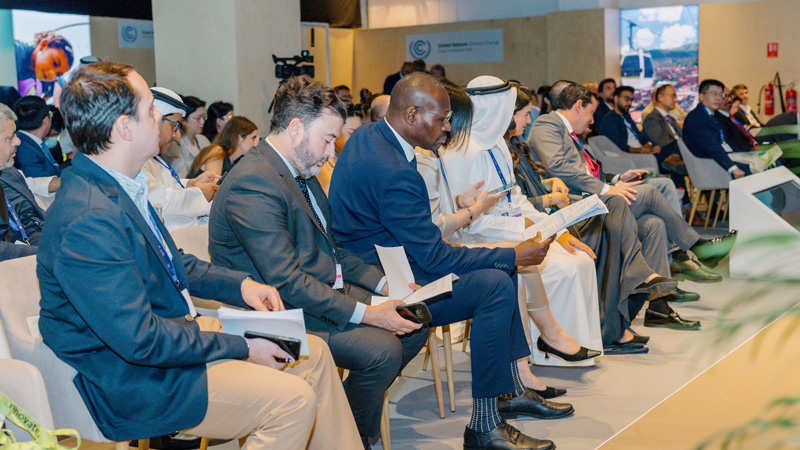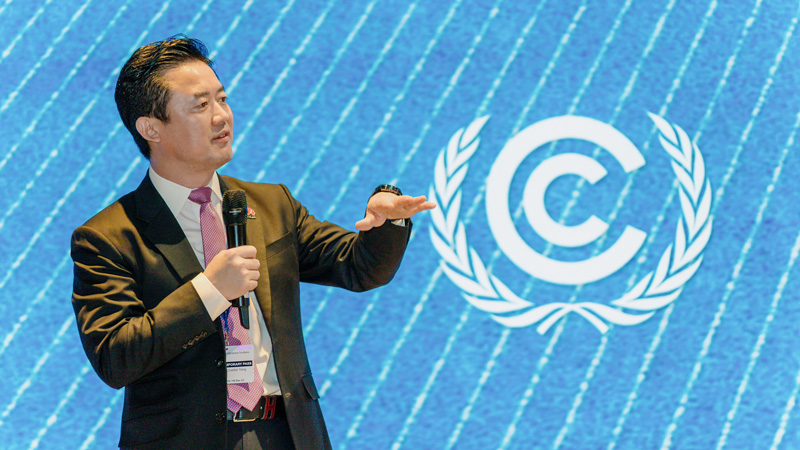[Dubai, United Arab Emirates, December 3, 2023] At the 28th UN Climate Change Conference (COP28), the UN Climate Change Global Innovation Hub (UGIH) and Huawei co-hosted a session titled "Innovative, Digitally Enabled Green Transition." At the event, Charles Yang, Senior Vice President of Huawei and President of Global Marketing, Sales and Services of Huawei Digital Power, shared Huawei's green development strategies and practices in his speech.

Charles said, we are now living in the era of carbon neutrality. Energy is the foundation for the development of our civilization. An energy transition is vital to our advancement efforts. Decarbonization, electrification, digitalization, and intelligence are four key pathways for the energy transition.

Integrating the Digital and Energy Worlds for a New Era of the Digital Energy Industry
To address the challenges implicated by carbon neutrality, the energy mix is rapidly evolving, calling for reducing carbon emissions in power generation. Clean energy will replace conventional energy, and renewables will dominate the future as their share in power generation will increase from 25% today to 91% by 2050. PV will develop as a main energy source with considerable annual growth in installed capacity. Energy storage will also play an irreplaceable role.
Electricity will become the main energy source that will be consumed in the future. The share of electricity in energy consumption will increase from 21% to 51% by 2050. Mobility electrification will play a pivotal role in the process. The International Renewable Energy Agency (IRENA) estimates that the number of electric vehicles will grow from 30 million at the end of last year to 2.18 billion.
Technologies such as 5G, AI, cloud, and blockchain keep evolving and are penetrating every part of our economy and civilization. Digital technologies will not only help improve efficiency but also build a foundation and platform for innovation, fueling a variety of industries.
Intelligent applications, such as AIGC models represented by ChatGPT, have triggered an explosion in intelligent computing power, which will continue to increase exponentially in the future. AI will be deeply integrated into the real economy. And it will change the way we work and drive a new round of technological and industrial advances. Propelled by digitalization and intelligence, new energy systems will emerge and evolve with closed-loop business models.
Following the trends of decarbonization, electrification, digitalization, and intelligence, the digital and energy worlds will be deeply integrated. It is fair to say that the energy industry has ushered in a new era of digital energy. Great changes will take place in energy infrastructure development. Digital, AI, and power electronics technologies will be further integrated. Power generation, grids, loads, and energy storage will collaborate in a profound way. Consequently, energy will be more efficiently utilized and resources will be better allocated.
Integrating Digital and Power Electronics Technologies to Develop Clean Power and Enable Energy Digitalization
While proposing green ICT technologies and innovative solutions to address environmental challenges, Huawei collaborates with customers and partners to build green ICT indicator systems, develop innovative green ICT infrastructure, and ultimately empower the energy transition.
The mission of Huawei Digital Power is to integrate digital and power electronics technologies, develop clean power, and enable energy digitalization to drive an energy revolution for a better, greener future. In the Digital Power business, Huawei focuses on clean power generation, energy digitalization, mobility electrification, green ICT power infrastructure, and integrated smart energy. By integrating bit, watt, heat, and battery (4T) technologies, Huawei teams up with partners to provide global customers with all-scenario low-carbon products and solutions as part of its contributions to carbon neutrality.
- Grid-forming ESS, Building the World's First 100% Renewables-Powered City
Huawei blends smart string controllers and smart string energy storage systems (ESSs) into its FusionSolar Grid-Forming Solution to facilitate a stable power grid connection with a high penetration of renewables. The solution has been applied in the 1.3 GWh microgrid for the Red Sea project in Saudi Arabia. Through the world's first GWh-level PV+ESS grid forming system, Huawei contributes to the first city that is fully powered by solar energy.
- Intelligent O&M with AI, Ensuring High Quality and Availability
In Gonghe County of Qinghai province, China, Huawei helped the State Power Investment Corporation build the world's largest PV power plant with a capacity of 2.2 GW, which generates more than 4 billion kWh of green electricity every year. The Smart I-V Curve Diagnosis technology shortens the inspection time from 5 months to 15 minutes, with the precision rate, recall rate, and reproduction rate exceeding 90%. The technology reduces O&M costs and ensures efficient operation of the power plant.
- Redefining the Driving and Charging Experience, Accelerating Global Mobility Electrification
Mobility electrification requires the coordinated development of vehicles and chargers. As a solution provider of power trains and charging networks, Huawei Digital Power values high-quality development of both on-board and off-board products. It has launched a hyper-converged powertrain system and a "1 km per second" ultra-fast charging solution. Together, they will create an extraordinary driving experience and refueling-like charging experience, giving a push to mobility electrification.
- Involving Telecom Network Facilities in Energy Production and Scheduling
While supporting the rapid growth of global connections, telecom networks are consuming over 300 billion kWh of electricity each year. Telecom operators can leverage more than 10 million base stations globally and become energy producers to slash carbon emissions. An increasing penetration of renewables compromises the stability of power grids, widening the peak-valley electricity price difference. To address the challenge, time-of-use (TOU) and virtual power plant (VPP) business models can be adopted for enhanced energy scheduling. In China, such models have been applied with favorable results.
- Collaborating with Partners to Build a Thriving Ecosystem for the Digital Energy Industry
As a tech product company, Huawei has developed world-leading technologies and highly reliable technology ecosystems over the past 30 years. In the energy field, it will leverage its strengths by integrating digital technologies and power electronics technologies to create unique value for the industry.
In the era with connectivity of everything, including all sources of energy, the digital and energy worlds are merging. Huawei Digital Power will continuously innovate in technologies and products, and team up with industry and ecosystem partners to build a thriving ecosystem for the digital energy industry.
Huawei Digital Power will work with customers to innovate and launch products that meet the needs of the industry, work with business and service partners to provide customers with high-quality solutions, and work with local industry partners to strengthen product cooperation and promote local industry upgrades. It will also collaborate with industrial organizations to enhance industrial policies, standards, and roadmaps for high-quality development.
The digital energy industry is booming and full of opportunities. As expected, all stakeholders will join forces to build a thriving industry ecosystem and start a new chapter for a better, greener future.

 Search
Search




 Search
Search


